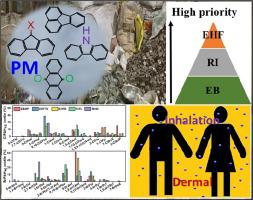Environment International ( IF 11.8 ) Pub Date : 2020-09-01 , DOI: 10.1016/j.envint.2020.106059 Ranran Liu 1 , Shengtao Ma 2 , Yangyi Yu 1 , Guiying Li 2 , Yingxin Yu 1 , Taicheng An 1

|
Extensive electronic waste (e-waste) recycling might be an important emission source of polycyclic aromatic hydrocarbons (PAHs) mixture, which might induce negative effects on the employees. In the present work, atmospheric pollution patterns of PAHs and their derivatives were determined in five different workshops to dismantle waste printed circuit boards (WPCBs) via thermal treatment. The results showed that mass concentrations of PAHs, chlorinated PAHs (ClPAHs), brominated PAHs (BrPAHs), oxy-PAHs (OPAHs) as well as carbazole (CBZ) were ranged from 1.53 × 104–2.02 × 105, 32.3–364, 8.29–1.13 × 103, 923–1.39 × 104 and 225–1.95 × 103 pg·m−3, respectively. Electric heating furnaces (EHF) workshops emitted relatively higher contaminants than other disposal sectors. OPAHs was found to be the most predominant derivatives of PAHs with 9,10-anthraquinone (83.0%) has the absolute superior in EHFTV, while benzo(a)anthracene-7,12-dione (>45.0%) was found to be the highest congener in other workshops, respectively. 9,10-Cl2Phe exhibited the largest contributions to the ΣClPAHs whereas the composition profiles of BrPAHs varied among five workshops. In addition to direct chlorination of parent PAHs, thermal degradation of halogenated flame retardants incorporated into plastic materials might dominate the generation of Cl/BrPAHs from e-waste dismantling activities. The specific isomeric ratios of BrPAHs (3-BrFlu/1-BrPyr and 1-BrPyr/3-BrFlu) might be used to discriminate other emission sources from pyrolysis of WPCBs. However, their specific application as novel tracers for source identification should be further verified with more studies. The emitted PAHs mixture with their derivatives in all dismantling workshops posed carcinogenic risks to these dismantling workers via inhalation, particularly the workshop using electric heating furnaces to treat router. Nevertheless, new loadings of PAHs derivatives observed from e-waste dismantling activities, as well as their comprehensive health risk assessment provides us with a fresh perspective on the source appointment and potential adverse consequences of PAHs. More attention needs to be paid to the potential carcinogenic risks of exposure to PAHs and their derivatives from e-waste dismantling processes.
中文翻译:

对PAH及其从电子废物拆解过程中散发的衍生物的现场研究及其对人体的综合影响。
广泛的电子废物(电子废物)回收可能是多环芳烃(PAHs)混合物的重要排放源,这可能会对员工产生负面影响。在目前的工作中,在五个不同的车间确定了多环芳烃及其衍生物的大气污染模式,以通过热处理拆除废印刷电路板(WPCB)。结果表明多环芳烃即质量浓度,氯化多环芳烃(ClPAHs),溴化多环芳烃(BrPAHs)以及咔唑(CBZ)从1.53×10不等,氧-多环芳烃(OPAHs)4 -2.02×10 5,32.3-364 ,8.29-1.13×10 3,923-1.39×10 4和225-1.95×10 3皮克·米-3, 分别。电加热炉(EHF)车间的污染物排放量高于其他处置部门。发现OPAH是PAHs的最主要衍生物,其中9,10-蒽醌(83.0%)在EHFTV中具有绝对优势,而苯并(a)蒽-7,12-二酮(> 45.0%)被认为是PAHs的绝对优势。分别是其他工作坊中最高的同类产品。9,10-氯2Phe对ΣClPAHs的贡献最大,而BrPAHs的组成特征在五个车间中有所不同。除了母体PAH的直接氯化作用外,掺入塑料材料中的卤化阻燃剂的热降解还可能占电子废物分解活动中Cl / BrPAHs的产生主导地位。BrPAHs的特定异构体比率(3-BrFlu / 1-BrPyr和1-BrPyr / 3-BrFlu)可用于区分其他排放源与WPCB的热解。但是,它们作为特定来源的新型示踪剂的具体应用应通过更多研究进一步验证。在所有拆解车间中,所排放的多环芳烃及其衍生物的混合物通过吸入对这些拆解工人构成致癌风险,尤其是使用电加热炉处理router刨机的车间。然而,从电子废物拆解活动中观察到的新的PAHs衍生物含量及其全面的健康风险评估为我们提供了有关PAHs的来源指定和潜在不利后果的崭新视角。需要更多地关注电子废物拆解过程中暴露于PAHs及其衍生物的潜在致癌风险。


























 京公网安备 11010802027423号
京公网安备 11010802027423号